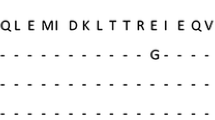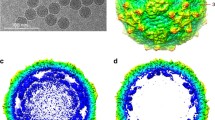Summary
The nonstructural glycoprotein NS28 of rotaviruses plays an important part in the assembly of double-shelled rotaviruses. C-terminal domains of the protein function as a receptor for single-shelled rotavirus particles at the membrane of the rough endoplasmic reticulum. In the present report we describe studies performed with a synthetic peptide corresponding to amino acid (aa) 160 to 169, the most hydrophilic C-terminal epitope of NS28. An antipeptide serum raised against this peptide demonstrated that this epitope was accessible in infected MA104 cells. Moreover, polymeric peptide was demonstrated to aggregate single-shelled rotavirus particles. This aggregation could be almost completely inhibited by preincubation with monomeric peptide. Our results clearly demonstrate that the epitope corresponding to aa 160–169 is able to bind single-shelled rotavirus particles.
Similar content being viewed by others
References
Au KS, Mattion NM, Estes MK (1993) A subviral particle binding domain on the rotavirus nonstructural glycoprotein NS28. Virology 194: 665–673
Bergmann CC, Maass D, Poruchynsky MS, Atkinson PH, Bellamy AR (1989) Topology of the non-structural rotavirus receptor glycoprotein NS28 in the rough endoplasmic reticulum. EMBO J 8: 1695–1703
Chan WK, Au KS, Estes MK (1988) Topography of the simian rotavirus nonstructural glycoprotein (NS28) in the endoplasmic reticulum membrane. Virology 164: 435–442
Hansen G, Mehnert F, Streckert HJ, Werchau H (1992) Monoclonal antipeptide antibodies recognize epitopes upon VP4 and VP7 of simian rotavirus SA11 in infected MA104 cells. Arch Virol 122: 281–291
Kabcenell AK, Poruchynsky MS, Bellamy AR, Greenberg HB, Atkinson PH (1988) Two forms of VP7 are involved in assembly of SA11 rotavirus in the endoplasmic reticulum. J Virol 62: 2929–2941
Kyte J, Doolittle RF (1982) A simple method for displaying the hydropathic character of a protein. J Mol Biol 157: 105–132
Maass DR, Atkinson PH (1990) Rotavirus proteins VP7, NS28 and VP4 form oligomeric structures. J Virol 64: 2632–2641
Meyer JC, Bergmann CC, Bellamy AR (1989) Interaction of rotavirus cores with the nonstructural glycoprotein NS28. Virology 171: 98–107
Okada Y, Richardson MA, Ikegami N, Nomoto A, Furuichi Y (1984) Nucleotide sequence of human rotavirus genome segment 10, an RNA encoding a glycosylated virus protein. J Virol 51: 856–859
Patton JT (1994) Rotavirus replication. Curr Top Microbiol Immunol 185: 107–127
Streckert HJ, Brüssow H, Werchau H (1988) A synthetic peptide corresponding to the clevage region of VP3 from rotavirus SA11 induces neutralizing antibodies. J Virol 62: 4265–4269
Streckert HJ, Grunert B, Werchau H (1986) Antibodies specific for the carboxy-terminal region of the major surface glycoprotein of simian rotavirus (SA11) and the human rotavirus (Wa). J Cell Biochem 30: 41–49
Streckert HJ, Werchau H (1988) Three amino acids of a heptapeptide-induced antibody are responsible for recognition of SV40 structural proteins. Immunobiology 177: 149–157
Suzuki H, Konno T, Numazaki Y (1993) Electron microscopic evidence for budding process-independent assembly of double shelled rotavirus particles during passage through endoplasmic reticulum membranes. J Gen Virol 74: 2015–2018
Taylor JA, O'Brian JA, Lord VJ, Meyer JC, Bellamy AR (1993) The RER-localized rotavirus intracellular receptor: a truncated purified soluble form is multivalent and binds virus particles. Virology 194: 807–814
Ward CW, Azad AA, Dyall-Smith MC (1985) Structural homologies between RNA segment 10 and 11 from UK bovine, simian SA11 and human WA rotaviruses. Virology 144: 328–336
Ziegner UHM, Frank I, Bernatowicz A, Starr SE, Streckert HJ (1992) Antibody-dependent cellular cytotoxicity (ADCC) is directed against immunodominant epitopes of the envelope proteins of human immunodeficiency virus 1 (HIV-1) Viral Immunol 5: 273–281
Author information
Authors and Affiliations
Rights and permissions
About this article
Cite this article
Olivo, M., Streckert, H.J. Studies on the single-shelled rotavirus receptor with a synthetic peptide derived from the cytoplasmic domain of NS28. Archives of Virology 140, 2151–2161 (1995). https://doi.org/10.1007/BF01323237
Received:
Accepted:
Issue Date:
DOI: https://doi.org/10.1007/BF01323237




